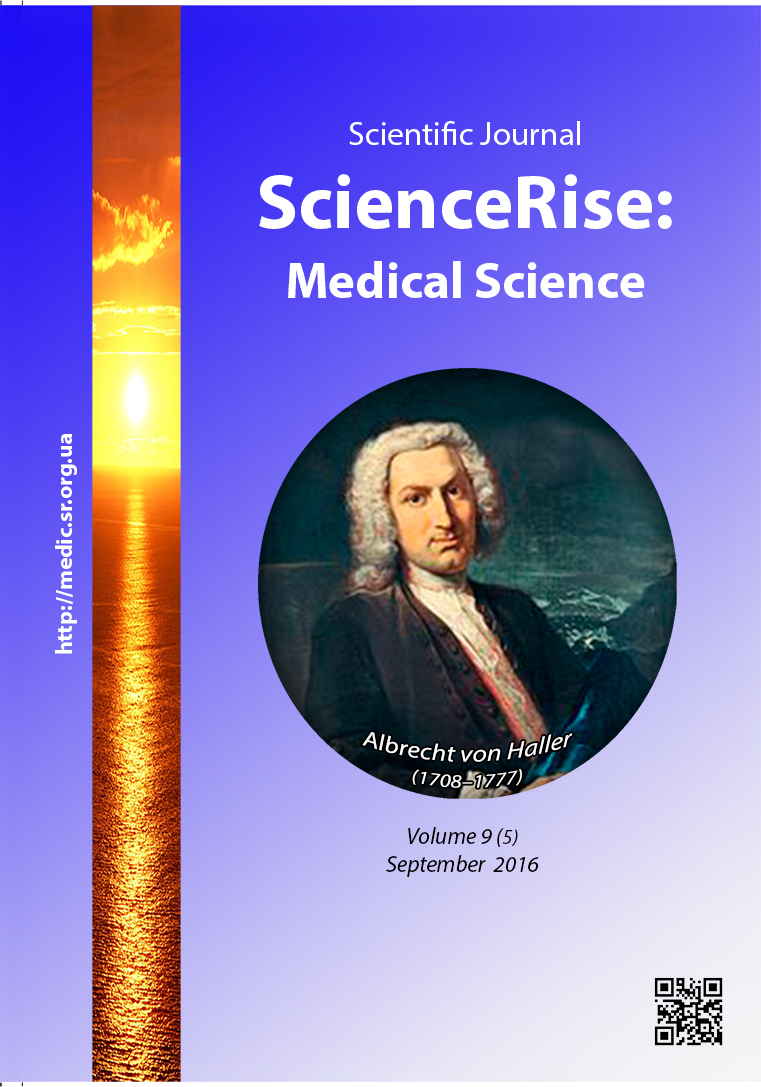The research of new markers of inflammation in patients with coronary artery disease and diabetes mellitus type 2
DOI:
https://doi.org/10.15587/2519-4798.2016.78127Keywords:
atherosclerosis, coronary disease, diabetes mellitus type 2, inflammation, inflammation markersAbstract
The prevalence of coronary disease among adult population of Ukraine is 9 %. This parameter increases with age and is 5–7 % at the age of 45–64 years and 10–14 % at the age of 65–84 years. In 2011 52 mln of European people at the age of 20–79 years suffered from diabetes mellitus and, according to prognostications of Diabetes International Federation, this rate will increase till 2030 up to 64 mln. People with coronary disease and concomitant diabetes mellitus are more inclined to the proinflammatory changes and thrombus creation comparing with ones, who do not suffer from diabetes mellitus. At present it is known, that inflammation plays the important role in atherogenesis, including initiation, development of the vascular wall injury, atheroma instability and appearance of thrombotic complications.
Atherosclerosis is considered as the long-term, torpid chronic inflammation in vascular intima. Such conception explains the connection between inflammation mediators and risk factors of atherosclerosis development. The changes of basal level of the new inflammation markers (Galectin-3, P-selectin) in patients with CD in combination with diabetes mellitus type 2 remains unstudied for today;
The aim of research is the study of the role of new pathogenetic markers of inflammation in patients with coronary disease and concomitant diabetes mellitus, elaboration of the methods of their correction, elaboration of the new approaches to therapy using the received results
References
- Kovalenko, V. M. (2014). Demografichni pokaznyki zdorovya naselenya Ukrainy. Kyiv.
- Stokes, K. Y., Granger, D. N. (2012). Platelets: a critical link between inflammation and microvascular dysfunction. The Journal of Physiology, 590 (5), 1023–1034. doi: 10.1113/jphysiol.2011.225417
- Paneni, F., Cosentino, F. (2014). Advanced glycation endproducts and plaque instability: a link beyond diabetes. European Heart Journal, 35 (17), 1095–1097. doi: 10.1093/eurheartj/eht454
- Mensah, G. A., Brown, D. W. (2007). An overview of cardiovascular disease burden in the United States. Health Affairs, 26 (1), 38–48. doi: 10.1377/hlthaff.26.1.38
- Wang, Y., Li, Y. (2007). The relationship between microalbuminuria and coronary artery lesions. Zhonghua Nei Ke Za Zhi, 46 (12), 981–983.
- Celermajer, D. S., Chow, C. K., Marijon, E., Anstey, N. M., Woo, K. S. (2012). Cardiovascular disease in the developing world: prevalences, patterns, and the potential of early disease detection. Journal of the American College of Cardiology, 60 (14), 1207–1216. doi: 10.1016/j.jacc.2012.03.074
- Szmitko, P. (2003). New markers of inflammation and endothelial cell activation: Part I. Circulation, 108 (16), 1917–1923. doi: 10.1161/01.cir.0000089190.95415.9f
- Pant, S., Deshmukh, A., GuruMurthy, G. S., Pothineni, N. V., Watts, T. E., Romeo, F., Mehta, J. L. (2013). Inflammation and Atherosclerosis–Revisited. Journal of Cardiovascular Pharmacology and Therapeutics, 19 (2), 170–178. doi: 10.1177/1074248413504994
- Duivenvoorden, R., Mani,V., Woodward, M., Kallend, D., Suchankova, G., Fuster, V. et. al. (2013). Relationship of serum inflammatory biomarkers with plaque inflammation assessed by FDG PET/CT. JACC: Cardiovascular Imaging, 6 (10), 1087–1094. doi: 10.1016/j.jcmg.2013.03.009
- Pant, R., Marok, R., Klein, L. W. (2014). Pathophysiology of coronary vascular remodeling. Cardiology in Review, 22 (1), 13–16. doi: 10.1097/crd.0b013e31829dea90
Downloads
Published
How to Cite
Issue
Section
License
Copyright (c) 2016 Мария Алексеевна Хвисюк

This work is licensed under a Creative Commons Attribution 4.0 International License.
Our journal abides by the Creative Commons CC BY copyright rights and permissions for open access journals.
Authors, who are published in this journal, agree to the following conditions:
1. The authors reserve the right to authorship of the work and pass the first publication right of this work to the journal under the terms of a Creative Commons CC BY, which allows others to freely distribute the published research with the obligatory reference to the authors of the original work and the first publication of the work in this journal.
2. The authors have the right to conclude separate supplement agreements that relate to non-exclusive work distribution in the form in which it has been published by the journal (for example, to upload the work to the online storage of the journal or publish it as part of a monograph), provided that the reference to the first publication of the work in this journal is included.









